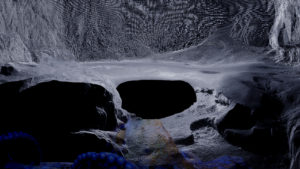The Intelligence of the Body to Come
This was published in the catalog accompanying If AI Were Cephalopod, Orphan Drift’s 2019 exhibition at the gallery, Telematic. It can be cited here as: Buckner, Clark. “The Intelligence of the Body to Come” www.clarkbuckner.com. Web. Day, Month, Year article as accessed.

If AI were Cephalopod. The collective artist 0rphan Drift begins with a speculative hypothesis. It evokes science fiction, fantasy, and horror, staging an encounter with an alien other – a sublime creature, at once monstrous and awe inspiring – whose very existence would seem to challenge the basic parameters of experience. Animal and artificial, a consciousness beyond human understanding, it is neither strictly natural nor cultural, neither merely organic nor technological. It is an embodied intelligence, a consciousness encoded in the flesh and the metabolism of its surroundings. It understands through touch and speaks in radiating colors through a semaphore of the skin. The creature is mythical: a god-like figure that holds us in thrall to its fascination. Yet, it is also somehow congenial, as if reaching out to communicate across millennia. Its strangeness is somehow familiar, somehow our own. At once more ancient and more sophisticated than we are, it is an evolutionary revenant, an alternative variation on the nervous system that still inhabits our bodies, as well as an avatar of the post-human future, a figure of the alien other that we are in the process of becoming, in fact have already become.
Since its inception in 1990’s London, 0rphan Drift has courted diverse forms of alien alterity in a neo-futurist attempt to imagine, indeed, to conjure possible embodiments and forms of consciousness. A shape-shifting leviathan in its own right, its work defies the Romantic paradigm of the isolated artist withdrawn to the studio to construct private symbolic spaces. Instead, it operates collectively, opening up to collaborative contributions from others, both among and beyond its original four core, all women members (Susie Karakashian, Ranu Mukherjee, Erle Stenberg, and Maggie Roberts), including underground musicians, critical theorists, media activists, and, more recently, coders, animators, scanners, and scientists, frequently from diverse, networked locations across the globe. Its work is often site-specific and performative, exceeding the boundaries of the art world and collapsing the distinction between process and product. It extensively employs sampling and re-mixing, mapping and collecting, citing ready-made artifacts and drawing upon discourses, whose meanings and effects exceed the artist’s intentions. Indeed, it treats the image as a contagion that infects the work from elsewhere.
0rphan Drift’s formal strategies are, in this respect, consistent with the content of its orienting concerns, which hinge in large measure on the complication of human and machine vision. Contemporary media are not exclusively, or even primarily, the providence of artists. They belong equally to the entertainment industry and computer engineers, podcasters and the police, inherently challenging the privilege of art as an autonomous field – effectively dissolving it within the broader, more eclectic field of visual culture. But 0rphan Drift’s work not only concerns the autonomy of art, it concerns the autonomy of the rational subject, more generally – the very sense of the subject as a disembodied consciousness, set apart from, or even standing over, others and the world, and the whole catalog of prejudicial, metaphysical hierarchies and oppositions that this entails. Beyond merely an instrument of our designs, 0rphan Drift approaches technology as a prosthetic supplement that is paradoxically integral to the original constitution of experience, what now has become undeniable as the real-time mediation of everyday life; and it conceives the glitch – the distorting effect of this technological mediation, or what the artist sometimes simply addresses as “machine vision” – as a generative disturbance, which compromises the strict boundaries between matter and spirit, history and myth to produce fluidities, which 0rphan Drift takes up and cultivates in its work as sites of becoming and radical change.
In If AI were Cephalopod, 0rphan Drift postulates an AI imagination coded by the somatic tendencies of the octopus, conceiving consciousness as, not only more artificial, more technologically distorted and dispersed than commonly understood, but also, as more rooted in the body and the sensuousness of the flesh. In fact, it presents a world in which these distinctions are not easily drawn and perhaps best discarded, a world in which the natural and the technological have become unavoidably enmeshed, as overlapping systems on which we depend and for which we find ourselves responsible. Drawing upon recent work in Embodied Cognitive Science and Radical Anthropology, 0rphan Drift effectively asks what paradigm of “intelligence,” do we presuppose in the development of Artificial Intelligence? Is it not perhaps a mistake at this juncture to privilege the human on account of its rational self-consciousness? Might it not be better, more appropriate, to imagine the intelligence of machines in light of, what we now recognize as, the remarkably complex cognition of other creatures? What alternative forms of experience and perception are revealed in doing so? And if intelligence is so understood, is human cognition not perhaps already more distributed than sometimes supposed, involving neither merely mind nor brain, but affects and intensities across the surfaces of the body and, even, the external world? 0rphan Drift poses these questions not only to the future, but also to the world in which we live. The promise of the new, the different, the artist postulates with its sublime kraken, ultimately lies not in the capacity of engineers to automate learning processes or anything else, but in our capacity to open ourselves to, even to cultivate, the alien other already in our midst.
